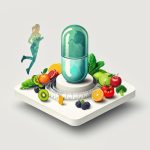Love blue crabs? You’re not alone! They’re delicious, but are they good for you? This article lays it all out: the good, the bad, and the delicious. We’ll look at what’s healthy about blue crabs, compare them to other seafood, and show you how to enjoy them safely. We’ll even give you tips to avoid any potential problems. So, whether you’re a seasoned crab eater or just curious, read on to learn how to make smart choices about adding blue crabs to your diet. For comparisons, see this article on the health benefits of trout: healthy trout options.
Are Blue Crabs Healthy? Exploring the Nutritional Benefits and Potential Downsides
Let’s talk about blue crabs – are they a healthy addition to your diet, or should you steer clear? The truth, as with most foods, is a bit more nuanced than a simple yes or no. Blue crabs offer some fantastic nutritional perks, but there are also potential downsides to consider. Let’s dive into the details and understand if they are truly a healthy dietary choice!
A Delicious Dose of Nutrients and Essential Minerals?
Blue crabs are a surprisingly good source of protein, the building block for strong muscles and tissues. Think of them as tiny packages of muscle-building power! A 3-ounce serving of cooked blue crab contains around 19 grams of protein. They’re also rich in vitamin B12, essential for keeping your nerves healthy and your red blood cells functioning properly. Blue crabs provide over 300% of your recommended daily value of B12 per 100 grams. And if you’re looking for a boost of selenium, an antioxidant that fights off cell damage, blue crabs deliver, providing over 100% of your daily needs in just 100 grams. They even contain omega-3 fatty acids, those heart-healthy fats you hear so much about. It’s like nature’s multivitamin, packed into a shell!
However, it’s not all sunshine and seafood. Many crab dishes are high in sodium, which can be a worry for people watching their blood pressure. A 3-ounce serving contains over 350 milligrams of sodium, which is 15% of the recommended daily limit. So, while the nutritional benefits are impressive, mindful eating is key. Remember that moderation plays a key role in a healthy lifestyle.
Potential Pitfalls: What You Should Know About Contamination and Allergies
While blue crabs are nutritious, there are a few potential downsides to be aware of. One is heavy metal contamination. Crabs can absorb heavy metals like mercury and cadmium from their environment. The amount of these metals varies depending on where the crabs are caught and what species they are. Brown crab meat can also have high levels of cadmium, which is toxic if you take in too much. This is particularly important for pregnant women and young children, who are more sensitive to the harmful effects of mercury. The FDA recommends that pregnant women consume at least 8 to 12 ounces of seafood with low mercury content per week. This is why choosing your seafood source wisely is so important.
Another important consideration is allergies. Shellfish allergies are quite common, and even a small amount of blue crab can trigger a serious reaction in someone with a shellfish allergy. Symptoms can range from mild nausea, hives, and stomach pain to severe anaphylaxis. Always check food labels carefully and be prepared to react if needed. If you have a shellfish allergy, it’s best to avoid blue crab altogether.
Smart Choices for Safe and Delicious Crab: A Consumption Guide
So, how can you enjoy delicious blue crabs while minimizing any risks? Here’s a guide to help you make informed choices:
- Source Matters: Choose sustainably sourced crabs from reputable suppliers. Look for certifications that ensure responsible fishing practices. This helps reduce your exposure to harmful heavy metals. Sustainably sourced options ensure responsible fishing practices. Atlantic Blue Crab and Dungeness Crab are good options.
- Moderation is Key: Limit yourself to one or two servings of blue crab per week. This helps manage your sodium intake and minimizes your exposure to potential heavy metals. Remember that portion control is essential for a balanced diet.
- Cooking Counts: Opt for healthier cooking methods like steaming or baking instead of frying or drenching the crab in butter. A little lemon juice and herbs go a long way in bringing out the crab’s natural flavor! This also helps eliminate unhealthy trans fats from your meal.
- Allergy Awareness is Paramount: If you have any shellfish allergies, avoid blue crab completely. Even a trace amount can cause a serious reaction. If you are unsure, consult your doctor or allergist.
- Know Your Source: Familiarize yourself with FDA guidelines on safe seafood consumption. They offer helpful advice to ensure you’re making healthy and informed choices. Staying informed improves your food safety practices and lowers health risks.
The Big Picture: Enjoying Blue Crabs Responsibly for Health and Wellness
So, are blue crabs healthy? The answer is a cautious “yes.” They offer valuable nutrients, contributing to a balanced diet. However, it’s crucial to consume them responsibly, keeping possible heavy metal contamination and allergic reactions in mind. By making smart choices and prioritizing safe food handling, you can enjoy these tasty crustaceans without compromising your health. Remember, informed choices lead to a more enjoyable and healthier eating experience. Ongoing research continues to refine our understanding of the environmental factors influencing seafood safety, so staying informed is always a good idea.
How to Safely Incorporate Crab Meat into a Balanced Diet and Healthy Lifestyle
Key Takeaways:
- Blue crab meat is a powerhouse of protein and essential nutrients, supporting muscle growth and overall health.
- However, potential risks like mercury and cadmium contamination need careful consideration, especially for vulnerable populations.
- Smart choices about sourcing, preparation, and portion sizes are key to enjoying crab safely and minimizing exposure to contaminants.
- Understanding the nutritional profile helps you make informed dietary decisions, contributing to a balanced eating plan.
Nutritional Powerhouse: The Good Stuff in Blue Crab that Boosts Health
Blue crabs boast an impressive nutritional profile. They’re a fantastic source of protein, vital for building and repairing tissues. Plus, they offer a decent dose of omega-3 fatty acids, beneficial for heart health and brain function. These crabs also contain essential vitamins and minerals, including vitamin B12 and selenium—both crucial for immune support and overall well-being. A serving provides a significant amount of protein, making blue crabs a good choice for those watching weight. They also provide a decent amount of calcium and iron content. A 3-ounce serving of blue crab offers just 74 calories, with roughly 85 percent of those calories coming from protein.
Potential Pitfalls: Navigating the Risks Associated with Crab Consumption
While blue crab offers many health benefits, it’s important to acknowledge the potential risks. Mercury contamination is a concern. The amount of mercury in crab varies depending on factors such as where and how the crab was caught. The other concern is cadmium, especially in the brown meat. Cadmium is a heavy metal that can be harmful in high levels. Finally, allergic reactions to shellfish are also a serious consideration.
Minimizing Risks: Your Guide to Safe Crab Consumption for a Balanced Diet
How to safely incorporate crab meat into a balanced diet involves a multi-pronged approach:
- Choose Wisely: Opt for sustainably sourced crabs from reputable vendors. Transparency in sourcing is vital. Look for certifications that indicate responsible fishing practices. Ask questions; knowledge is power. To limit exposure, stick to eating the white crab meat and avoid brown meat, roe, and crab hepatopancreas. This ensures environmentally friendly harvesting methods.
- White Meat is Your Friend: White crab meat generally has lower levels of cadmium compared to brown meat. Stick to the white meat. Prioritizing white meat helps reduce heavy metal exposure.
- Portion Control: Limit your crab consumption to reasonable portions (approximately 3-4 ounces). This helps minimize your intake of potential contaminants and sodium. Practicing portion control ensures a balanced eating pattern.
- Preparation Matters: Rinse canned crab to reduce sodium content. Thorough cooking kills harmful bacteria. Thorough cooking minimizes exposure to unsafe microorganisms.
- Know Your Limits: If you have a shellfish allergy, avoid crab entirely. If unsure, consult your doctor. This protects individuals against the adverse side effects of allergic reactions.
Blue Crab in Your Balanced Diet: Making it Work for a Healthy Lifestyle
A balanced diet incorporates a variety of foods. Blue crab can definitely be part of a healthy eating plan. Just remember to follow these guidelines to minimize risks and maximize benefits. Think of it as a delicious treat, enjoyed as part of your overall healthy eating pattern, not as a staple. Try to include fresh fruits, vegetables, and whole grains in your diet too.
Beyond the Plate: Long-Term Considerations for Responsible Consumption
Consistent awareness is crucial. Diversifying your seafood consumption helps reduce exposure to any single contaminant. Consider supplementing your diet with omega-3s if your crab intake is limited. Regular health check-ups allow for monitoring of cholesterol and sodium levels, which is vital for overall health. Furthermore, blue crab’s methyl mercury levels is 0.065 PPM (Parts Per Million). Monitoring these markers assists in maintaining optimal health.
Nutritional Profile and Health Benefits of Crab Meat: A Comprehensive Review for Informed Choices
Key Takeaways:
- Blue crab meat is a powerhouse of protein and healthy omega-3 fatty acids, supporting muscle growth and cardiovascular
- Weight Loss Supplements That Work and Those That Dont - October 31, 2025
- Male Eating Disorders Often Missed but Increasingly Prevalent - October 29, 2025
- Males With Anorexia Nervosa Have Distinct Symptoms and Treatment Needs - October 28, 2025










